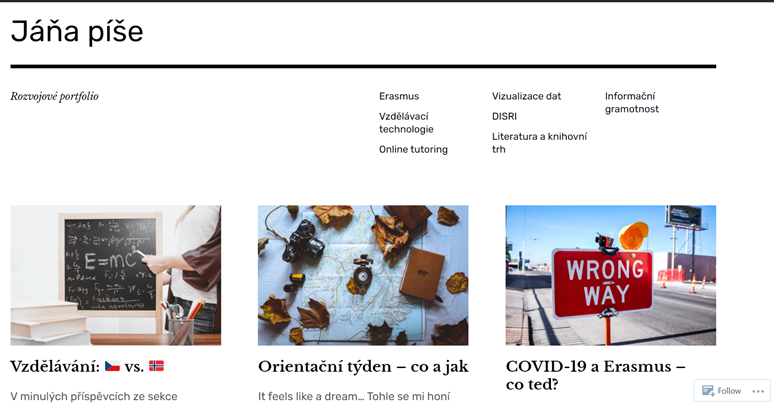Have a look, for example, at these portfolios:
- Vojtěch Hamerský (student)
- Jáňa Kříbková (student)
- Kryštof Davídek (student)
- Anna Puchovská (student)
- Hanka Matějková (student/graduate)
- Radim Chalupník (student/graduate)
- David Kudrna (student/graduate)
- Hana Tulinská (professional/teacher)
- Michal Černý (professional/teacher)
- Patrick Green (professional/from abroad)
Why learn publicly?
A portfolio or publishing parts of one’s learning process belongs to a learning society – we use technologies to teach ourselves something, gain feedback and present ourselves regardless of geographical distance or time. Just as you gain inspiration from social networks or from your favorite bloggers, you can also inspire one another in class (either in your school or globally). While online, you can gain feedback from your classmates, teachers and other experts who can help you take the next step.
Can a portfolio be used in school?
A portfolio can be used with various distinctions at all levels – basic, secondary, university and lifelong learning even though you’ve already completed your formal education. For example, portfolios are used by a basic school in Ludgeřovice, Brno’s Scio School, and other artistically-oriented secondary schools and universities with a focus on teaching.

If portfolios are used in a school, it means that you’re collecting your tasks in one place and following your own progress. You can then approach your portfolio in two ways:
- For final evaluations within your subjects.
- For final examinations, i.e. leaving exams and university graduation exams.
For example, students at Masaryk University’s Department of Information and Library Studies are going to take their university graduation exams. Together, we reflect on the student’s path, which is simply more visible in the portfolio than it is in their individual marks.
Reflection and feedback are the strongest elements of using portfolios. A portfolio allows us to see ourselves in the mirror, and lets us see where we’ve come from, where we’re going, and how we’re doing in the process. A portfolio is also an easy way to acquire tailored feedback. We can easily send someone a link to our portfolio, whether it’s a teacher or someone else. Then, they can see our work not only independently, but also in the context of other work.
How to begin
First you should know what you want to use the portfolio for – think about the differences between presentations and a development portfolio. Browse through various portfolios, get inspiration, and read a few tutorials. Then you can give it a try yourself. You can gradually begin to think about posts that you’ll add to your blog feed. Ideally, you’ll tag your posts so both you and your readers can orient yourselves within them.